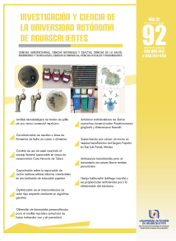Optimización de un intercambiador de calor tipo serpentín mediante un algoritmo genético
DOI:
https://doi.org/10.33064/iycuaa2024924752Palabras clave:
intercambiador de calor, calor transferido, caída de presión, tubos por fila, algoritmo genético, optimizaciónResumen
Se presenta el desarrollo de un sistema formado por un algoritmo de diseño/cálculo de intercambiadores de calor tipo serpentín y un algoritmo genético para optimización; el primero considera variables de importancia en el diseño de intercambiadores de calor, y el segundo explora aleatoriamente, en el primero, diferentes combinaciones de estas variables. El objetivo es optimizar el calor transferido y la caída de presión, expresadas a través de la relación, y el número de tubos por fila. Para el algoritmo genético las variables de entrada se restringen a rangos que estén dentro de lo físicamente funcional. Se obtuvieron valores optimizados de 11012 W para , 15.44 kPa para , y 18 tubos/fila para. El valor optimizado de representa incrementos de 43% y 31% en comparación con el valor más alto observado en los experimentos y con el valor de diseño obtenido con un paquete computacional comercial, respectivamente.
Descargas
Citas
• Al-Obaidi, M.A., Li, J.P., Kara-Zaïtri, C., & Mujtaba, I.M. (2017). Optimisation of reverse osmosis based wastewater treatment system for the removal of chlorophenol using genetic algorithms. Chemical Engineering Journal, 316, 91-100. DOI: https://doi.org/10.1016/j.cej.2016.12.096
• Cao, E. (2010). Heat Transfer in Process Engineering. New York: McGraw Hill.
• Colburn, A.P. (1951). Problems in Design and Research on Condensers of Vapours and Vapour Mixtures. General Discussion on Heat Transfer arranged by the Institution of Mechanical Engineers and the American Society of Mechanical Engineers, 448-458. DOI: https://doi.org/10.1243/PIME_PROC_1951_164_048_02
• Glavan, M., Gradišar, D., Invitto, S., Humar, I., Juričić, Ð., Pianese, C., & Vrančić, D. (2016). Cost optimisation of supermarket refrigeration system with hybrid model. Applied Thermal Engineering, 103, 56-66. DOI: https://doi.org/10.1016/j.applthermaleng.2016.03.177
• Imran, M., Pambudi, N.A., & Farooq, M. (2017). Thermal and hydraulic optimization of plate heat exchanger using multi objective genetic algorithm. Case Studies in Thermal Engineering, 10, 570-578. DOI: https://doi.org/10.1016/j.csite.2017.10.003
• Jafari-Marandi, R., & Smith, B.K. (2017). Fluid Genetic Algorithm (FGA). Journal of Computational Design and Engineering, 4, 158-167. DOI: https://doi.org/10.1016/j.jcde.2017.03.001
• Kayabasi, E., & Kurt, H. (2018). Simulation of heat exchangers and heat exchanger networks with an economic aspect. Engineering Science and Technology, an International Journal, 21, 70-76. DOI: https://doi.org/10.1016/j.jestch.2018.02.006
• Liu, C., Bu, W., & Xu, D. (2017). Multi-objective shape optimization of a plate-fin heat exchanger using CFD and multi-objective genetic algorithm. International Journal of Heat and Mass Transfer, 111, 65-82. DOI: https://doi.org/10.1016/j.ijheatmasstransfer.2017.03.066
• Liu, Q., Tao, Y., Shi, L., Zhou, T., Huang, Y., Peng, Y., Wang, Y., & Tu, J. (2023). Parametric optimization of a spiral ground heat exchanger by response surface methodology and multi-objective genetic algorithm. Applied Thermal Engineering, 221, paper 119824. DOI: https://doi.org/10.1016/j.applthermaleng.2022.119824
• Raja, B.D., Vivek, P., & Jhala, R.L. (2017). Thermal design and optimization of fin-and-tube heat exchanger using heat transfer search algorithm. Thermal Science and Engineering Progress, 4, 45-57. DOI: https://doi.org/10.1016/j.tsep.2017.08.004
• Shih, Y.-C., Lee, Y.-C., & Lin, K-C. (2023). Optimized design on the thermohydraulic performance of the helical coil heat exchanger. International Journal of Thermofluids, 17, paper 100271. DOI: https://doi.org/10.1016/j.ijft.2022.100271
• Wang, L., Sundén, B., & Manglik, R.M. (2007). Plate Heat Exchangers: Design, Applications and Performance. Southampton, UK: WIT Press.
• Xie, G.N., Sunden, B., & Wang, Q.W. (2008). Optimization of compact heat exchangers by a genetic algorithm. Applied Thermal Engineering, 28, 895-906. DOI: https://doi.org/10.1016/j.applthermaleng.2007.07.008
Descargas
Publicado
Cómo citar
Licencia
Derechos de autor 2024 Ricardo Del Castillo-Tinajero, Esperanza Rodríguez-Morales, José Julián III Montes-Rodríguez

Esta obra está bajo una licencia internacional Creative Commons Atribución-NoComercial-CompartirIgual 4.0.
Las obras publicadas en versión electrónica de la revista están bajo la licencia Creative Commons Atribución-NoComercial-CompartirIgual 4.0 Internacional (CC BY-NC-SA 4.0)









